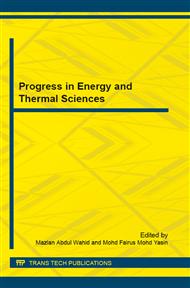p.219
p.223
p.228
p.231
p.237
p.242
p.246
p.250
p.254
Removal of Oil Using Activated Carbon from Textile Sludge Biochars
Abstract:
The study of oil pollution is crucial nowadays and considered as one of the critical issues as oil pollution gives bad effects especially to wastewater treatment facilities. For that purpose, this study investigated the potential of activated carbon from biochars of textile sludge precursors for oil removal. The activated carbons were produced from biochar obtained through the pyrolysis of textile sludge waste by chemical activation with 1M of phosphoric acid which denoted as AC-B-H3PO4. Apart from that, the performance of adsorptive properties of the activated carbon was tested using simulated cooking oil waste water in homogeneous form as the targeted adsorbate. The effect of adsorption contact time and initial concentration of simulated oil wastewater towards performances of AC-B-H3PO4 in removal of simulated oil wastewater were studied and compared with biochars700. The equilibrium time in adsorption of the simulated oil wastewater for both biochar700 and AC-B-H3PO4 was obtained in 30min. Meanwhile, the effects of initial concentration of simulated oil wastewater, biochars700 has earlier achieved equilibrium at 300mg/l up to 500 mg/l, while for AC-B-H3PO4, the adsorption capacity still increase at a high initial concentration of simulated oil waste water but in a slow rate. The results obtained showed that AC-B-H3PO4 has more potential for oil spills treatment than biochars due to its ability to treat the high initial concentration of simulated oil wastewater at the equilibrium time. The findings also provide for an alternative for low cost and effective adsorbent for the oil pollution treatment.
Info:
Periodical:
Pages:
237-241
Citation:
Online since:
January 2016
Authors:
Keywords:
Price:
Сopyright:
© 2016 Trans Tech Publications Ltd. All Rights Reserved
Share:
Citation:


